Melt Memory Effect in Polyethylene Random Terpolymer with Small Amount of 1-Octene and 1-Hexene Co-Units: Non-Isothermal and Isothermal Investigations
Abstract
:1. Introduction
2. Experimental Section
2.1. Materials
2.2. DSC Tests
3. Results and Discussion
4. Conclusions
Author Contributions
Funding
Data Availability Statement
Conflicts of Interest
References
- Gao, H.; Vadlamudi, M.; Alamo, R.G.; Hu, W. Monte Carlo Simulations of Strong Memory Effect of Crystallization in Random Copolymers. Macromolecules 2013, 46, 6498–6506. [Google Scholar] [CrossRef]
- Richardson, M.J.; Flory, P.J.; Jackson, J.B. Crystallization and melting of copolymers of polymethylene. Polymer 1963, 4, 221–236. [Google Scholar] [CrossRef]
- Alamo, R.G.; Mandelkern, L. Thermodynamic and structural properties of ethylene copolymers. Macromolecules 1989, 22, 1273–1277. [Google Scholar] [CrossRef]
- Mathot, V.B.F.; Pijpers, M.F.J. Molecular Structure, Melting Behavior, and crystallinity of VLDPE. J. Appl. Polym. Sci. 1990, 39, 979–994. [Google Scholar] [CrossRef]
- Alamo, R.G.; Mandelkern, L. Crystallization kinetics of random ethylene copolymers. Macromolecules 1991, 24, 6480–6493. [Google Scholar] [CrossRef]
- Alamo, R.G.; Chan, E.K.M.; Mandelkern, L.; Voigt-Martin, I.G. Influence of molecular weight on the melting and phase structure of random copolymers of ethylene. Macromolecules 1992, 25, 6381–6394. [Google Scholar] [CrossRef]
- Alamo, R.G.; Mandelkern, L. The crystallization behavior of random copolymers of ethylene. Thermochim. Acta 1994, 238, 155–201. [Google Scholar] [CrossRef]
- Lu, L.; Alamo, R.G.; Mandelkern, L. Lamellar Thickness Distribution in Linear Polyethylene and Ethylene Co-polymers. Macromolecules 1994, 27, 6571–6576. [Google Scholar] [CrossRef]
- Hauser, G.; Schmidtke, J.; Strobl, G. The Role of Co-Units in Polymer Crystallization and Melting: New Insights from Studies on Syndiotactic Poly(propene-co-octene). Macromolecules 1998, 31, 6250–6258. [Google Scholar] [CrossRef]
- Crist, B.; Howard, P.R. Crystallization and Melting of Model Ethylene−Butene Copolymers. Macromolecules 1999, 32, 3057–3067. [Google Scholar] [CrossRef]
- Häfele, A.; Heck, B.; Hippler, T.; Kawai, T.; Kohn, P.; Strobl, G. Crystallization of poly(ethylene-co-octene): II Melt memory effects on first order kinetics. Eur. Phys. J. E 2005, 16, 217–224. [Google Scholar] [CrossRef] [PubMed]
- Lauritzen, J.I.; Hoffman, J.D. Formation of Polymer Crystals with Folded Chains from Dilute Solution. J. Chem. Phys. 1959, 31, 1680–1681. [Google Scholar] [CrossRef]
- Mandelkern, L.; Fatou, J.G.; Howard, C. The Nucleation of Long-Chain Molecules. J. Pshysical. Chem. 1965, 69, 956–959. [Google Scholar] [CrossRef]
- Hoffman, J.D.; Miller, R.L. Kinetic of crystallization from the melt and chain folding in polyethylene fractions revisited: Theory and experiment. Polymer 1997, 38, 3151–3212. [Google Scholar] [CrossRef]
- Haigh, J.; Nguyen, C.; Alamo, R.; Mandelkern, L. Crystallization and melting of model polyethylenes with different chain structures. J. Therm. Anal. Calorim. 2000, 59, 435–450. [Google Scholar] [CrossRef]
- Androsch, R.; Wunderlich, B. Analysis of the Degree of Reversibility of Crystallization and Melting in Poly(ethylene-co-1-octene). Macromolecules 2000, 33, 9076–9089. [Google Scholar] [CrossRef]
- Alamo, R.G. The role of defect microstructure in the crystallization behavior of metallocene and MgCl2-supported Ziegler-Natta isotactic poly(propylenes). Polímeros 2003, 13, 270–275. [Google Scholar] [CrossRef] [Green Version]
- Alamo, R.G.; Blanco, J.A.; Agarwal, P.K.; Randall, J.C. Crystallization Rates of Matched Fractions of MgCl2-Supported Ziegler Natta and Metallocene Isotactic Poly(Propylene)s. 1. The Role of Chain Microstructure. Macromolecules 2003, 36, 1559–1571. [Google Scholar] [CrossRef]
- Hu, W.; Mathot, V.B.F.; Frenkel, D. Phase Transitions of Bulk Statistical Copolymers Studied by Dynamic Monte Carlo Simulations. Macromolecules 2003, 36, 2165–2175. [Google Scholar] [CrossRef] [Green Version]
- Randall, J.C.; Alamo, R.G.; Agarwal, P.K.; Ruff, C.J. Crystallization Rates of Matched Fractions of MgCl2-Supported Ziegler-Natta and Metallocene Isotactic Poly(propylene)s. 2. Chain Microstructures from a Supercritical Fluid Fractionation of a MgCl2-Supported Ziegler−Natta Isotactic Poly(propylene). Macromolecules 2003, 36, 1572–1584. [Google Scholar] [CrossRef]
- Razavi-Nouri, M. Studies of comonomer distributions and molecular segregations in metallocene-prepared poly-ethylenes by DSC. Polym. Test. 2006, 25, 1052–1058. [Google Scholar] [CrossRef]
- Strobl, G. Crystallization and melting of bulk polymers: New observations, conclusions and a thermodynamic scheme. Prog. Polym. Sci. 2006, 31, 398–442. [Google Scholar] [CrossRef]
- Reid, B.O.; Vadlamudi, M.; Mamun, A.; Janani, H.; Gao, H.; Hu, W.; Alamo, R.G. Strong memory effect of crystallization above the equilibrium melting point of random copolymers. Macromolecules 2013, 46, 6485–6497. [Google Scholar] [CrossRef]
- Mamun, A.; Chen, X.; Alamo, R.G. Interplay between a Strong Memory Effect of Crystallization and Liquid–Liquid Phase Separation in Melts of Broadly Distributed Ethylene–1-Alkene Copolymers. Macromolecules 2014, 47, 7958–7970. [Google Scholar] [CrossRef]
- Liu, P.; Xue, Y.; Men, Y. Melt Memory Effect beyond the Equilibrium Melting Point in Commercial Isotactic Polybutene-1. Ind. Eng. Chem. Res. 2019, 58, 5472–5478. [Google Scholar] [CrossRef]
- Sangroniz, L.; Cavallo, D.; Müller, A.J. Self-Nucleation Effects on Polymer Crystallization. Macromolecules 2020, 53, 4581–4604. [Google Scholar] [CrossRef]
- Zhao, X.; Han, S.; Song, W.; Liu, L.; Men, Y. Self-nucleation and heterogeneous nucleation in ethylene/1-octene random copolymer and its linear polyethylene blends. Thermochim. Acta 2022, 718, 179392. [Google Scholar] [CrossRef]
- Zhao, X.-T.; Men, Y.-F. Fractionation of Polyolefin Elastomer by a Modified SSA Technique. Chin. J. Polym. Sci. 2022, 40, 1252–1258. [Google Scholar] [CrossRef]
- Zhao, X.T.; Men, Y.F. Thermal Fractionation of Polyolefins: Brief History, New Developments and Future Perspective. Polym. Sci. Ser. A 2022, in press. [CrossRef]
- Chen, X.; Mamun, A.; Alamo, R.G. Effect of Level of Crystallinity on Melt Memory Above the Equilibrium Melting Temperature in a Random Ethylene 1-Butene Copolymer. Macromol. Chem. Phys. 2015, 216, 1220–1226. [Google Scholar] [CrossRef]
- Wang, Y.; Lu, Y.; Zhao, J.; Jiang, Z.; Men, Y. Direct Formation of Different Crystalline Forms in Butene-1/Ethylene Copolymer via Manipulating Melt Temperature. Macromolecules 2014, 47, 8653–8662. [Google Scholar] [CrossRef]
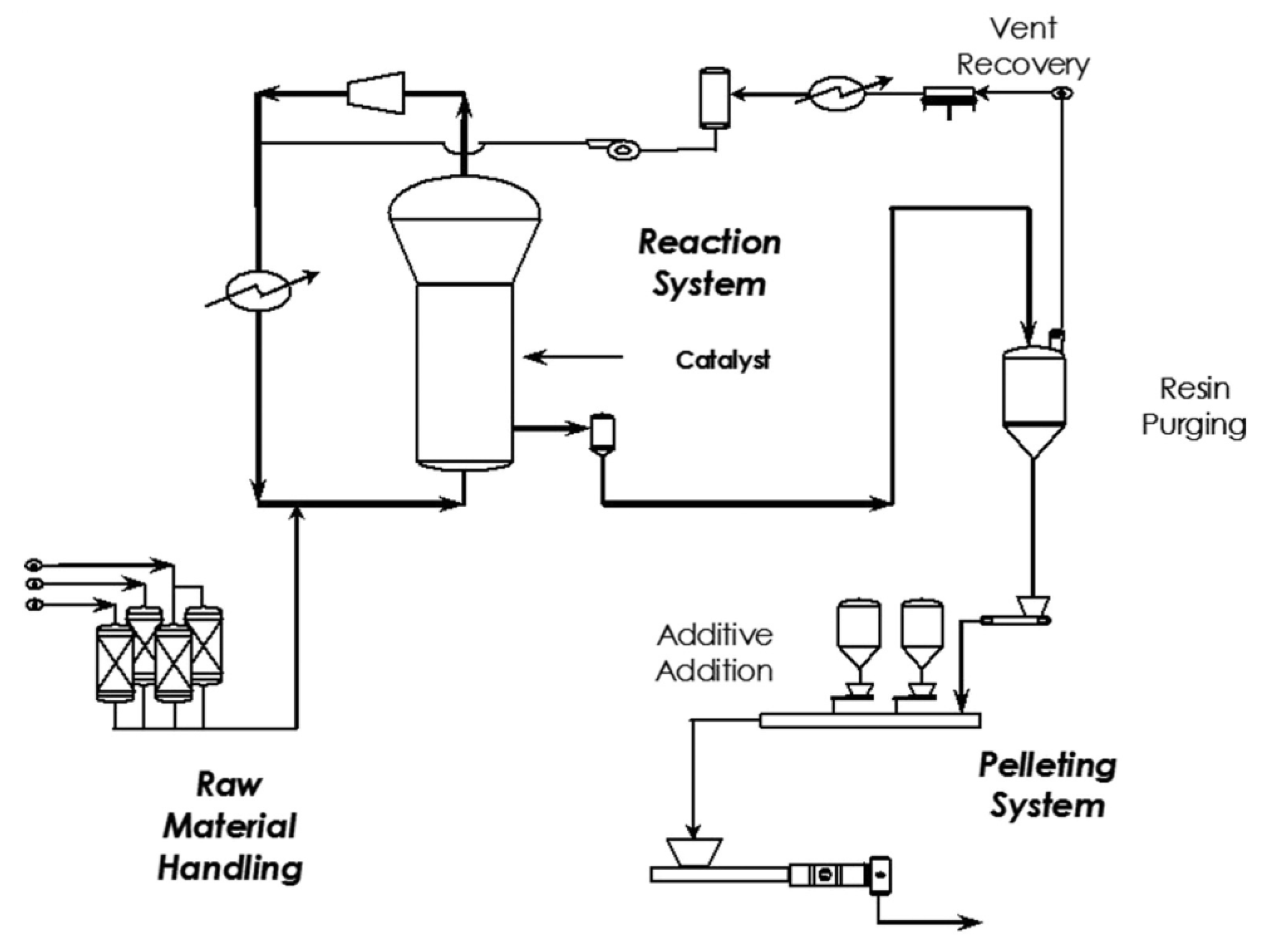



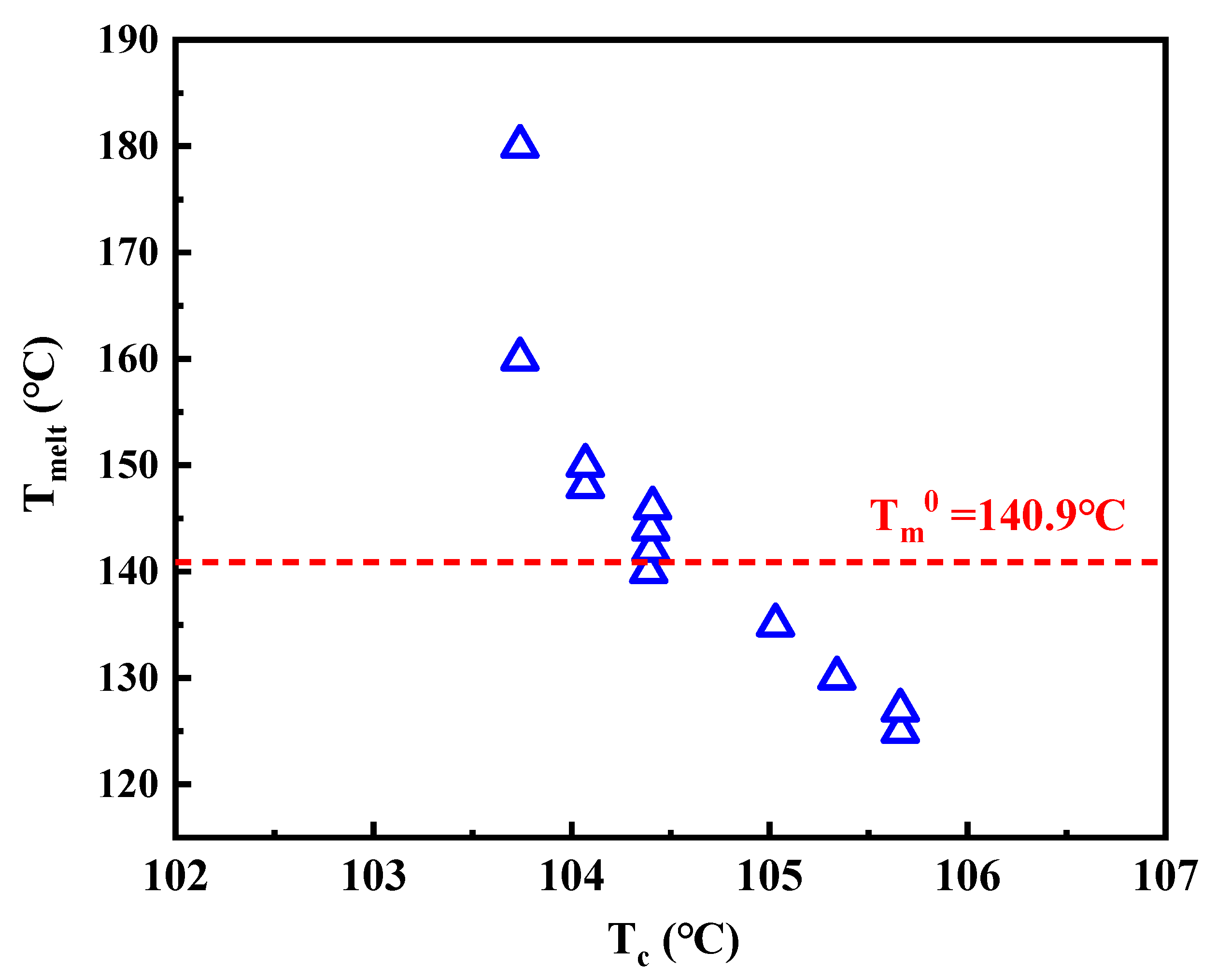
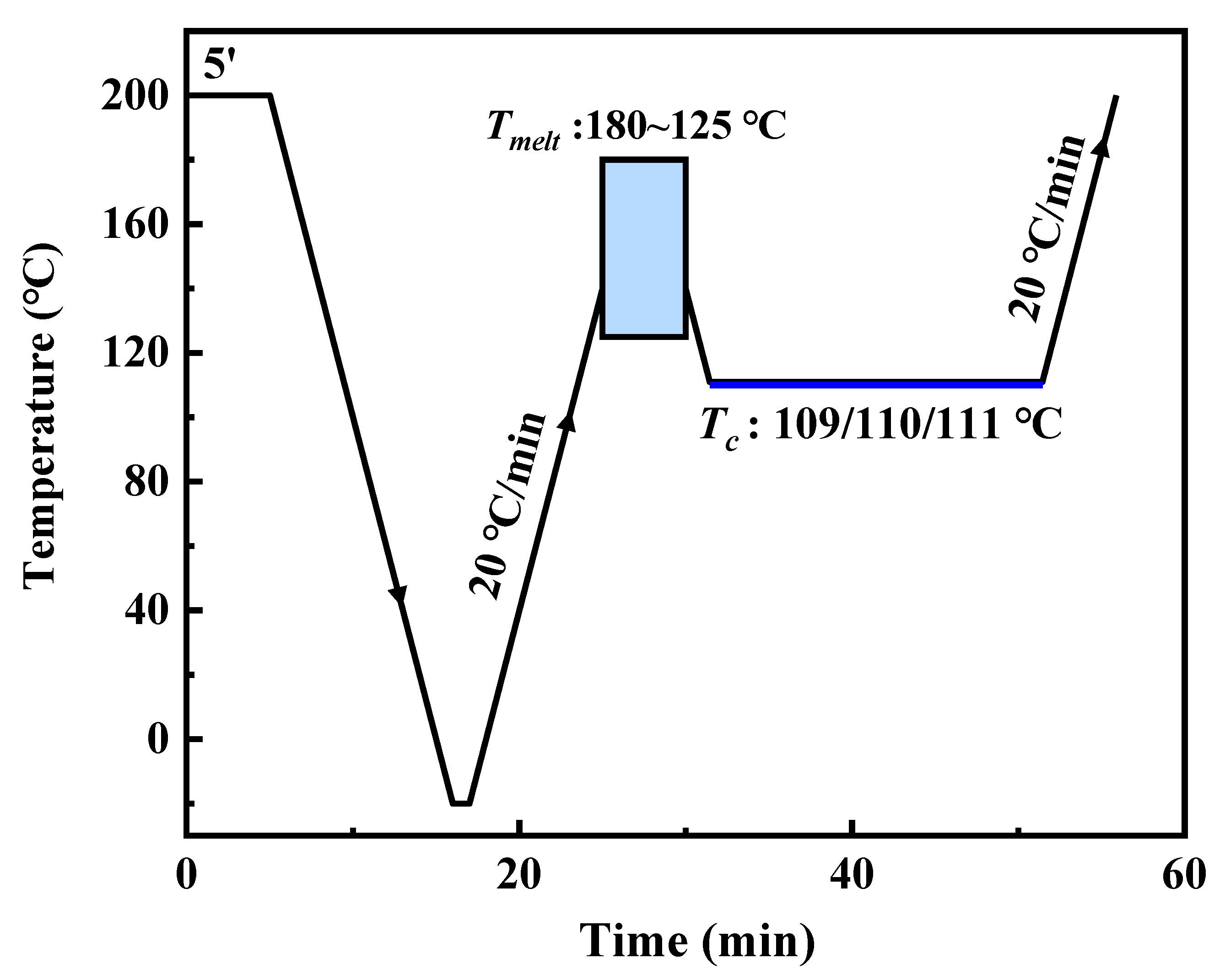
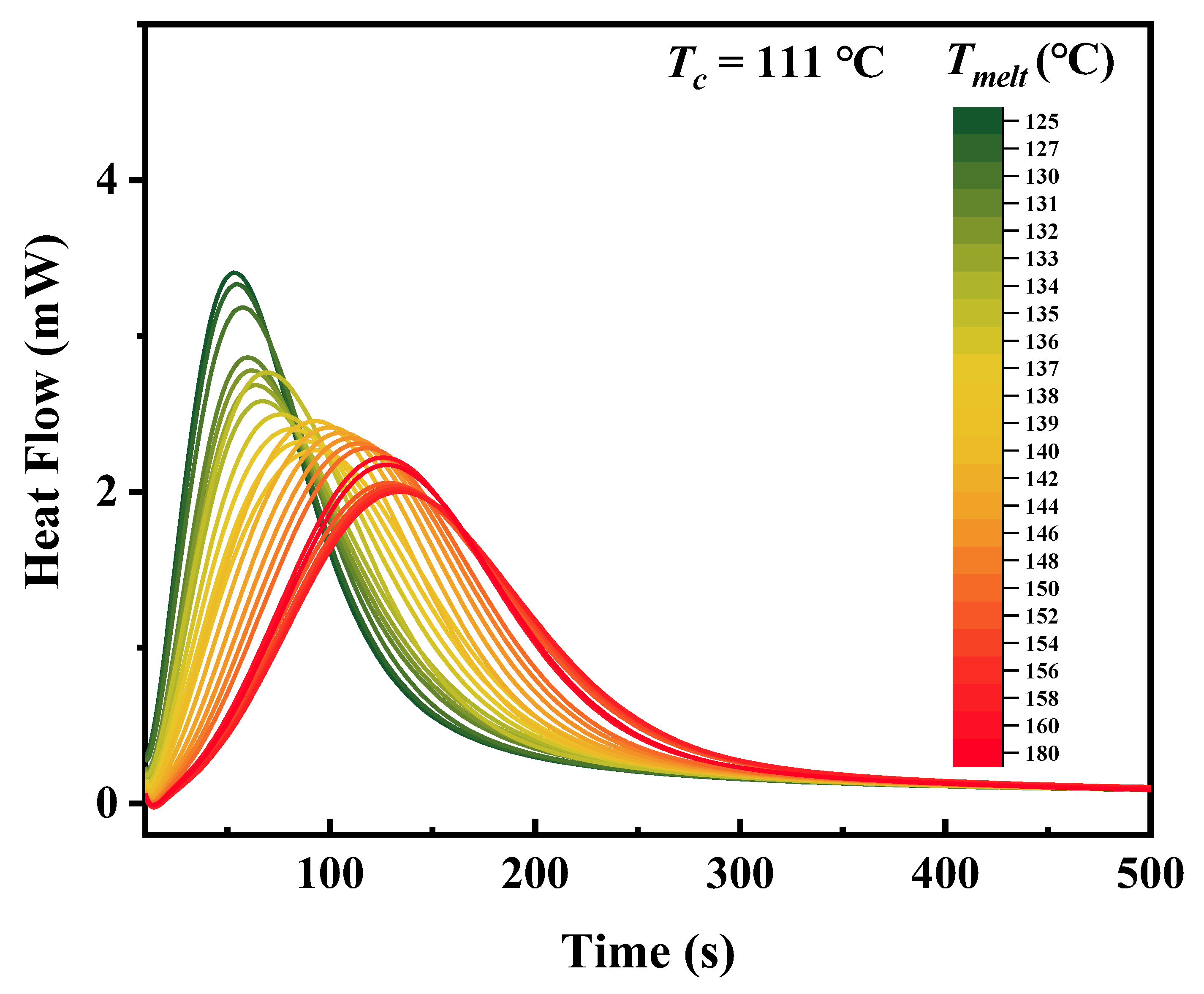
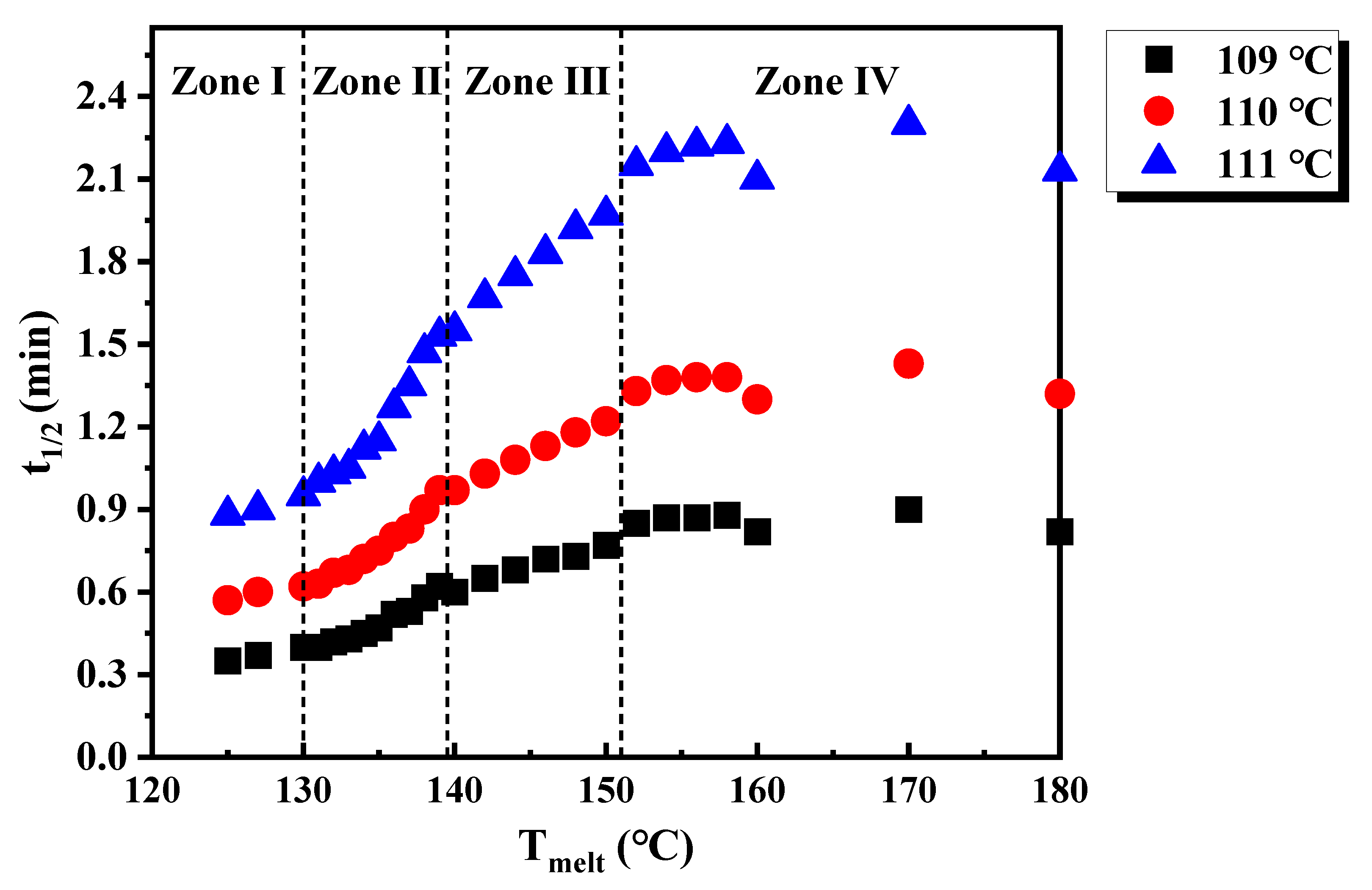
| Sample | Ethylene (mol%) | Octene (mol%) | Hexene (mol%) | Mw (g/mol) | Mn (g/mol) | Mw/Mn | Tm a (°C) | Φw b (%) |
|---|---|---|---|---|---|---|---|---|
| P(E-co-O-co-H) | 98.9 | 0.8 | 0.3 | 106,600 | 41,700 | 2.55 | 116.2 | 42.1 |
Disclaimer/Publisher’s Note: The statements, opinions and data contained in all publications are solely those of the individual author(s) and contributor(s) and not of MDPI and/or the editor(s). MDPI and/or the editor(s) disclaim responsibility for any injury to people or property resulting from any ideas, methods, instructions or products referred to in the content. |
© 2023 by the authors. Licensee MDPI, Basel, Switzerland. This article is an open access article distributed under the terms and conditions of the Creative Commons Attribution (CC BY) license (https://creativecommons.org/licenses/by/4.0/).
Share and Cite
Wang, D.; Li, S.; Lu, Y.; Wang, J.; Men, Y. Melt Memory Effect in Polyethylene Random Terpolymer with Small Amount of 1-Octene and 1-Hexene Co-Units: Non-Isothermal and Isothermal Investigations. Polymers 2023, 15, 1721. https://doi.org/10.3390/polym15071721
Wang D, Li S, Lu Y, Wang J, Men Y. Melt Memory Effect in Polyethylene Random Terpolymer with Small Amount of 1-Octene and 1-Hexene Co-Units: Non-Isothermal and Isothermal Investigations. Polymers. 2023; 15(7):1721. https://doi.org/10.3390/polym15071721
Chicago/Turabian StyleWang, Dengfei, Shiyan Li, Ying Lu, Jian Wang, and Yongfeng Men. 2023. "Melt Memory Effect in Polyethylene Random Terpolymer with Small Amount of 1-Octene and 1-Hexene Co-Units: Non-Isothermal and Isothermal Investigations" Polymers 15, no. 7: 1721. https://doi.org/10.3390/polym15071721
APA StyleWang, D., Li, S., Lu, Y., Wang, J., & Men, Y. (2023). Melt Memory Effect in Polyethylene Random Terpolymer with Small Amount of 1-Octene and 1-Hexene Co-Units: Non-Isothermal and Isothermal Investigations. Polymers, 15(7), 1721. https://doi.org/10.3390/polym15071721





